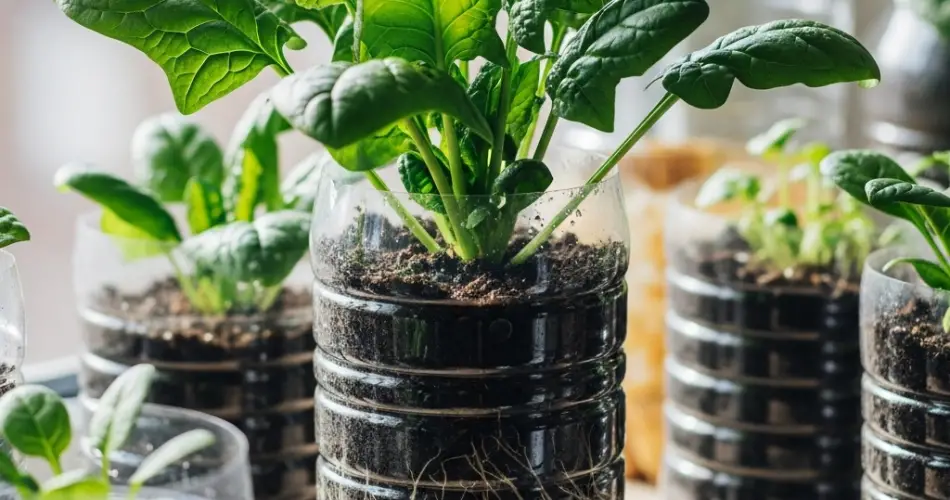Growing your own spinach doesn’t require a large garden plot, expensive pots, or complicated equipment. With just a simple plastic bottle, you can grow fresh, tender spinach leaves right at home. This method works well for balconies, windowsills, patios, or even indoor spaces with good lighting. It’s an easy, cost-effective way to go from seed to salad in just a few weeks.
Why Spinach Works Well in Bottles
Spinach has relatively shallow roots, which makes it a great candidate for container growing. It also matures quickly, allowing you to enjoy multiple harvests in a short time. Bottles serve as compact, lightweight containers that save space, conserve water, and can be moved easily to follow the sun or avoid bad weather.
Choosing the Right Spinach Variety
When growing in bottles, choose fast-growing, compact varieties. Some good options include:
-
Baby Spinach – Tender, mild, and quick to harvest.
-
Bloomsdale Long Standing – Tolerates a bit of heat and has crinkled leaves.
-
Space Spinach – Smooth leaves and good disease resistance.
Baby spinach varieties are ideal if you want frequent harvests of young leaves.
Preparing Your Bottle Planter
-
Select the Bottle – Use a clean, 1.5–2-liter plastic bottle. Clear bottles allow you to monitor soil moisture, but avoid keeping them in direct hot sunlight for long periods, as this can overheat roots.
-
Cut the Bottle – Slice it horizontally about one-third from the top. You can use the bottom as the planter and keep the top section inverted as a funnel for watering.
-
Add Drainage Holes – Puncture several small holes in the base to prevent waterlogging.
-
Optional Self-Watering Setup – Insert a cotton wick through the bottle’s neck into a small water reservoir below to keep soil evenly moist without daily watering.
Soil Preparation
Spinach prefers fertile, well-draining soil. For bottle growing, use a light potting mix:
-
50% potting soil
-
30% coco coir or peat moss
-
20% compost or worm castings
Mix in a small amount of slow-release organic fertilizer before planting to ensure steady nutrition.
Sowing Spinach Seeds
-
Fill the Bottle – Add your soil mix up to about 3 cm from the rim.
-
Plant the Seeds – Sow 3–4 seeds evenly spaced in the bottle, about 1–1.5 cm deep.
-
Water Lightly – Moisten the soil gently using a spray bottle or by pouring slowly to avoid displacing seeds.
-
Germination – Spinach seeds typically sprout in 5–10 days, depending on temperature.
Ideal Growing Conditions
-
Light – Spinach needs at least 4–6 hours of bright, indirect sunlight daily. In hot climates, protect plants from intense afternoon sun to prevent bolting. Indoors, a small LED grow light can supplement natural light.
-
Temperature – Best growth occurs between 10–24°C (50–75°F). Cooler weather keeps leaves tender and delays flowering.
-
Moisture – Keep soil consistently moist but never waterlogged. Bottles can dry out quickly, so check daily.
Caring for Bottle-Grown Spinach
-
Thinning – Once seedlings have two true leaves, thin them so the strongest plant remains in each bottle. This ensures proper root and leaf development.
-
Fertilizing – Feed every 2–3 weeks with diluted liquid organic fertilizer to encourage leafy growth.
-
Mulching – A thin layer of coco coir or straw on top of the soil can help retain moisture and reduce temperature swings.
Harvesting Your Spinach
Spinach leaves can be harvested as soon as they’re large enough to eat, usually within 25–35 days for baby leaves. Use the cut-and-come-again method:
-
Snip outer leaves about 2–3 cm above the base.
-
Leave the central growth intact to produce more leaves.
-
This allows for multiple harvests from the same plant over several weeks.
For a steady supply, start new bottles every two weeks so you always have fresh plants ready to pick.
Common Issues and Solutions
-
Bolting (flowering early) – Caused by heat or long daylight hours. Keep bottles in a cooler, shaded area during hot weather.
-
Yellow Leaves – Often due to overwatering or nutrient deficiency. Adjust watering and feed with a balanced fertilizer.
-
Slow Growth – Could be from low light. Move plants to a sunnier spot or add supplemental lighting.
Benefits of the Bottle Method
-
Space-efficient and portable
-
Reuses plastic bottles, reducing waste
-
Saves water compared to traditional garden beds
-
Affordable and beginner-friendly
-
Allows year-round growing with indoor setups
Final Tips for Success
If you’re growing indoors, place bottles near a bright window or under grow lights. Outdoors, rotate them occasionally so all sides receive light evenly. Keep a few extra bottles sown at different times to maintain a continuous harvest.
With this simple method, you can enjoy fresh, healthy spinach without a traditional garden. All it takes is a bottle, some seeds, and a little care to go from seed to salad in just a few weeks.



